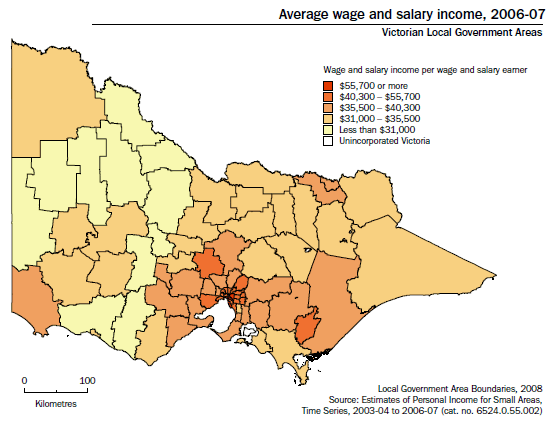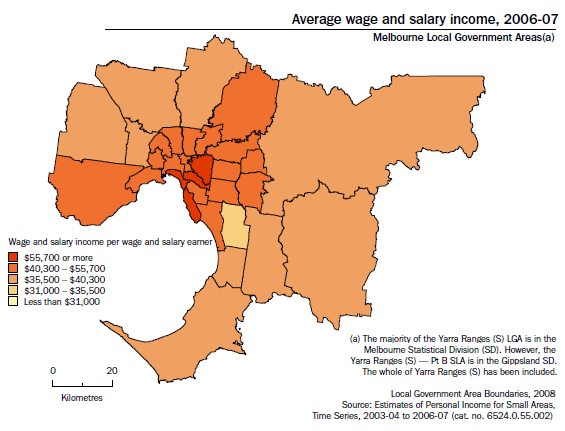SMALL AREA ESTIMATES OF PERSONAL INCOME
Estimates at small area level (including SLAs and LGAs) of the personal income people received from various sources for each year from 2003-04 to 2006-07 have recently been compiled by the ABS from aggregate data sourced from the Australian Taxation Office's (ATO) Individual Income Tax Return Database. The ATO database covers all individuals who submit an individual income tax return and includes persons with income from one or more of a range of sources such as wages and salaries, own business, superannuation and annuity, investments and government pensions, benefits or allowances. The data items compiled by the ABS using the ATO statistics relate to income standards the ABS uses for its income surveys and are defined in the Explanatory Notes of Estimates of Personal Income for Small Areas, Time Series, 2003-04 to 2006-07 (cat. no. 6524.0.55.002). Government pensions, benefits or allowances have been excluded from the scope of the ABS-compiled statistics. Downloadable data can be accessed from the Downloads page of the same publication.
Between 2003-04 and 2006-07, the total personal income of Victorians grew at an average annual rate of 7.2%, with those living in the Melbourne MSR (7.6%) recording a higher average annual growth rate than those living in the Balance of Victoria MSR (5.9%). Across Australia, personal income grew at an average annual rate of 8.2%.
Among LGAs in Victoria, the highest average annual growth rate in total personal income between 2003-04 and 2006-07 was observed in the Melbourne LGA (15.7%), followed by Wyndham (11.7%) and Melton (10.3%), while the lowest positive average annual rates of growth were observed in Loddon (1.4%), Ararat (2.1%) and Horsham (2.4%). Greater Dandenong (5.1%) recorded the lowest average annual growth rate in the Melbourne MSR. Over the period, negative average annual growth rates were observed in some LGAs in the Wimmera and Mallee: West Wimmera (-11.2%), Hindmarsh (-8.7%), Yarriambiack (-5.6%) and Buloke (-2.4%). Conversely, Surf Coast (9.7%) had the highest average annual growth rate among LGAs in the Balance of Victoria MSR.
Although the total personal income of Victorians from all sources grew between 2003-04 and 2006-07, each income source grew at a different rate. Superannuation and annuity income (average annual growth rate of 14.7%) and investment income (14.6%) showed the fastest rates of growth, while wage and salary income (6.2%) and own unincorporated business income (2.7%) grew at slower rates. As a result of these differing rates of growth, the share of total personal income sourced from wages and salaries decreased from 80.1% to 77.8%, and that from own unincorporated businesses decreased from 6.6% to 5.8%. Conversely, income from investments increased from 9.9% to 12.1%, and income from superannuation and annuities increased from 2.8% to 3.4%.
The amount of personal income earned in aggregate will be influenced by the number of income earners, which in turn will be affected by factors such as regional population growth and economic activity. In Victoria between 2003-04 and 2006-07, the number of wage and salary earners increased at an average annual rate of 2.3%. While total wage and salary income grew at an average annual rate of 6.2% over the period, average wage and salary income per wage and salary income earner grew at a slower average annual rate of 3.8%. Corresponding to the fastest growth in total personal income, the LGAs of Melbourne, Wyndham and Melton had the fastest growth in the number of wage and salary earners.
In 2006-07, there were more than 2.3 million wage and salary earners in Victoria, who earned a total of $95.3 billion in wages and salaries, giving an average wage and salary income of $41,260 per wage and salary earner. LGAs in the inner eastern and southern areas of Melbourne had the highest average wage and salary incomes, with the highest being Bayside ($60,138), Stonnington ($59,693) and Boroondara ($56,422). Conversely, LGAs with the lowest average wage and salary incomes were located in rural areas in the west of the state, with the lowest being Buloke ($26,813), Yarriambiack ($27,321) and West Wimmera ($27,930).
Between 2003-04 and 2006-07, all LGAs in Victoria recorded an average annual growth rate of more than 2.0% in average wage and salary income, with the fastest growth being in Glenelg (average annual growth rate of 5.2%), Towong and Corangamite (both 4.9%).


 Print Page
Print Page
 Print All
Print All
 Print Page
Print Page
 Print All
Print All